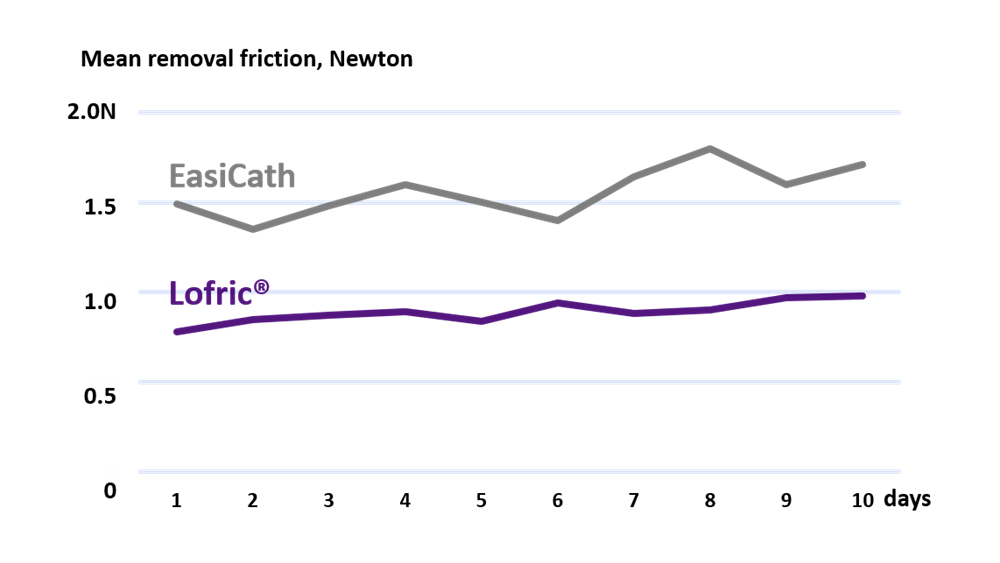
Urine often has a high concentration of particles and low content of water. This is referred to as high osmolality. Urine osmolality has a direct effect on catheter lubrication and plays an important role for people who use hydrophilic catheters. A catheter with a surface osmolality in balance with urine is key to reducing withdrawal friction.
A recent review acknowledges that there are variations in the quality of coatings among hydrophilic catheters and proposes osmolality as one important factor to consider when comparing different hydrophilic catheters.1 It has been concluded that the outer layer of the hydrophilic coated catheter should possess the same osmolality as the urine2 and that high osmolality hydrophilic catheters are recommended to minimize risk of urethral trauma, catheter sticking and patient discomfort.3
The LoFric catheter is characterised by the Urotonic™ Surface Technology. This means that the catheter has a surface layer isotonic to urine, i.e. the salt concentration of the catheter’s surface is in balance with the urine. Isotonic osmolality prevents removal of the hydrophilic coating from the surface. This is essential for keeping high lubricity and minimal friction between catheter and urethra during the entire catheterisation process, including at withdrawal. According to peer-reviewed data, LoFric with the Urotonic Surface Technology, is the only available hydrophilic coated catheter that could demonstrate high osmolality (i.e. ~900 mOsm/kg58) that corresponds to osmolality levels normally present in urine i.e. 800-1200 mOsm/kg4 5. This may be one contributing factor to the low complication rates associated with long-term LoFric use found in real-life evidence.6 A recent meta-analysis has identified a unique hematuria risk reduction of 48%, only applicable for the LoFric-brand.7 8
LoFric documentation: Low friction
- Design of a simulated urethra model for the quantitative assessment of urinary catheter lubricity.9
In vitro study of LoFric and other hydrophilic catheters presenting evidence on low insertion/withdrawal friction. - The importance of osmolality for intermittent catheterization of the urethra.3
Histology study in rabbit showing evidence of lower friction and less epithelial cell damage with the high osmolality LoFric catheter. - The importance of osmolality in hydrophilic urethral catheters: a crossover study.2
Cross-over study of LoFric and another hydrophilic catheter in 14 users providing evidence that high osmolality of the hydrophilic coating results in less sticking and lower withdrawal friction. For example, 3 incidents of sticking were observed in 2 patients among LoFric users while 42 incidents of sticking were observed in 9 patients among users of another hydrophilic catheter.

Graph based on results published in Waller et al. 1997
This cross-over study investigates 14 male spinal cord injured patients who tested LoFric and another hydrophilic catheter (EasiCath) for ten days in a randomised order. Removal friction was measured, and although both had hydrophilic coating, LoFric with its high osmolality showed 55% lower removal friction (p<0.001). Events of catheter-sticking inside the urethra were different with 3 incidents in 2 patients among LoFric-users compared to 42 incidents in 9 patients among users of the other hydrophilic catheter. An inverse correlation between osmolality measurements was reported. Osmolality measurement reported 900 and 950 mOsm/kg for LoFric and 15 and 80 mOSm/kg for the other hydrophilic catheter.